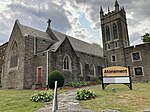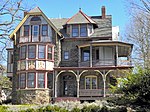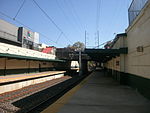Tulpehocken station
Former Pennsylvania Railroad stationsGermantown, PhiladelphiaHistoric district contributing properties in PennsylvaniaNRHP infobox with nocatNational Register of Historic Places in Philadelphia ... and 6 more
Philadelphia Register of Historic PlacesRailway stations in PhiladelphiaRailway stations in the United States opened in 1878Railway stations on the National Register of Historic Places in PennsylvaniaSEPTA Regional Rail stationsUse mdy dates from August 2023

Tulpehocken station is a SEPTA Regional Rail station in Philadelphia, Pennsylvania. Located at 333 West Tulpehocken Street in the Germantown neighborhood, it serves the Chestnut Hill West Line. The Pennsylvania Railroad built the station in 1878. The station is in zone 2 on the Chestnut Hill West Line, and is 8.5 track miles from Suburban Station. In 2004, this station saw 176 boardings on an average weekday.
Excerpt from the Wikipedia article Tulpehocken station (License: CC BY-SA 3.0, Authors, Images).Tulpehocken station
Wayne Avenue, Philadelphia
Geographical coordinates (GPS) Address Nearby Places Show on map
Geographical coordinates (GPS)
| Latitude | Longitude |
|---|---|
| N 40.0351 ° | E -75.1868 ° |
Address
Wayne Avenue 6152
19144 Philadelphia
Pennsylvania, United States
Open on Google Maps









